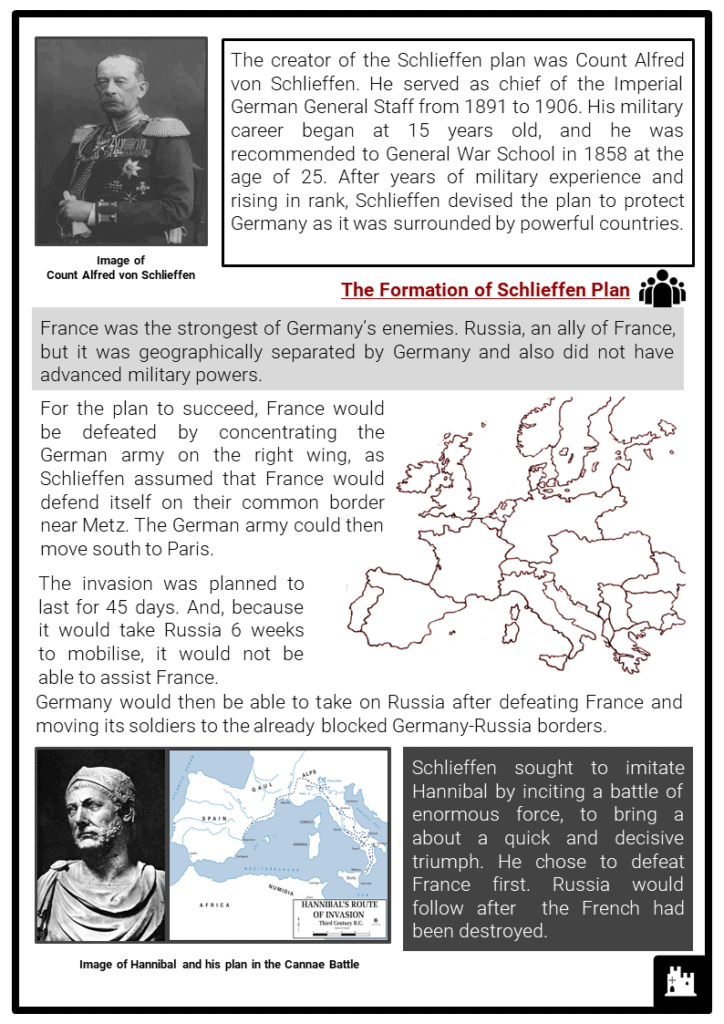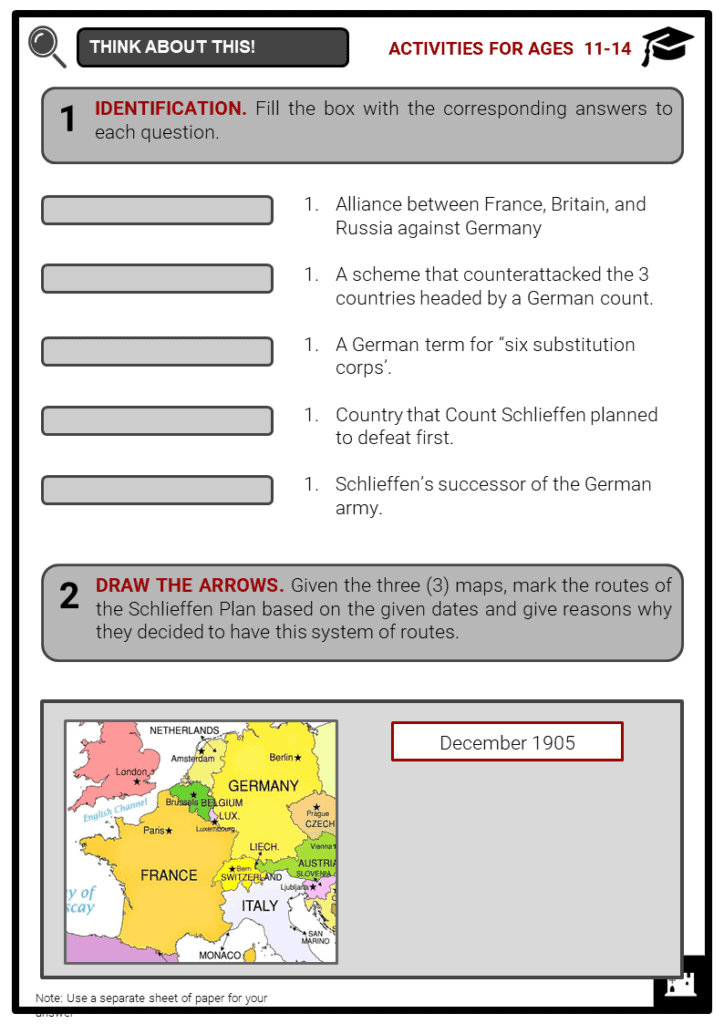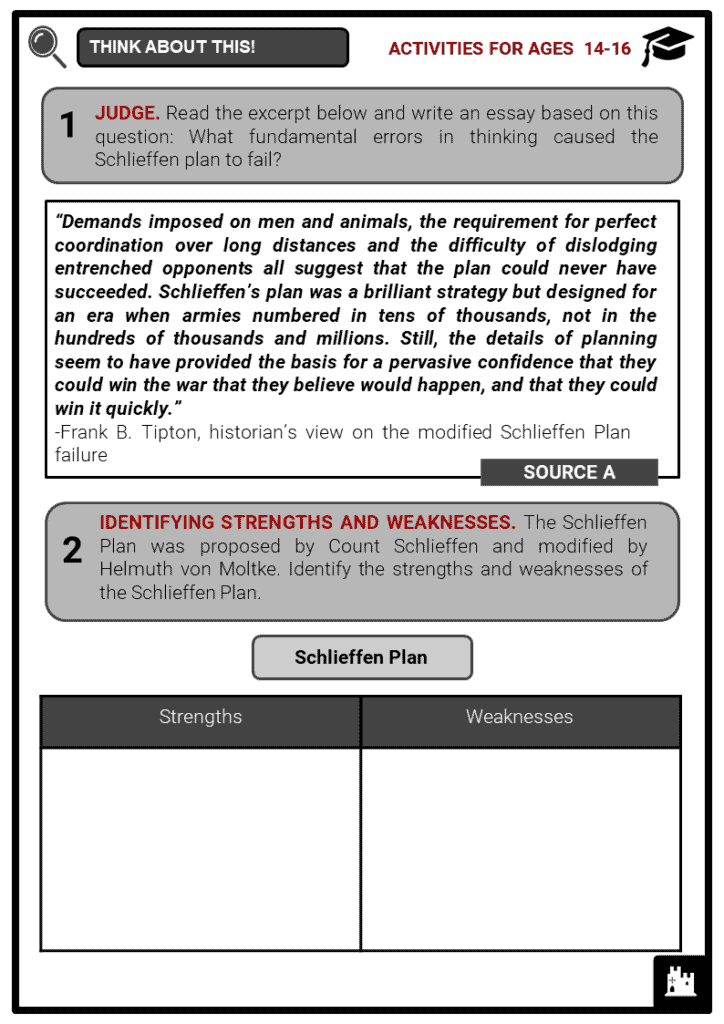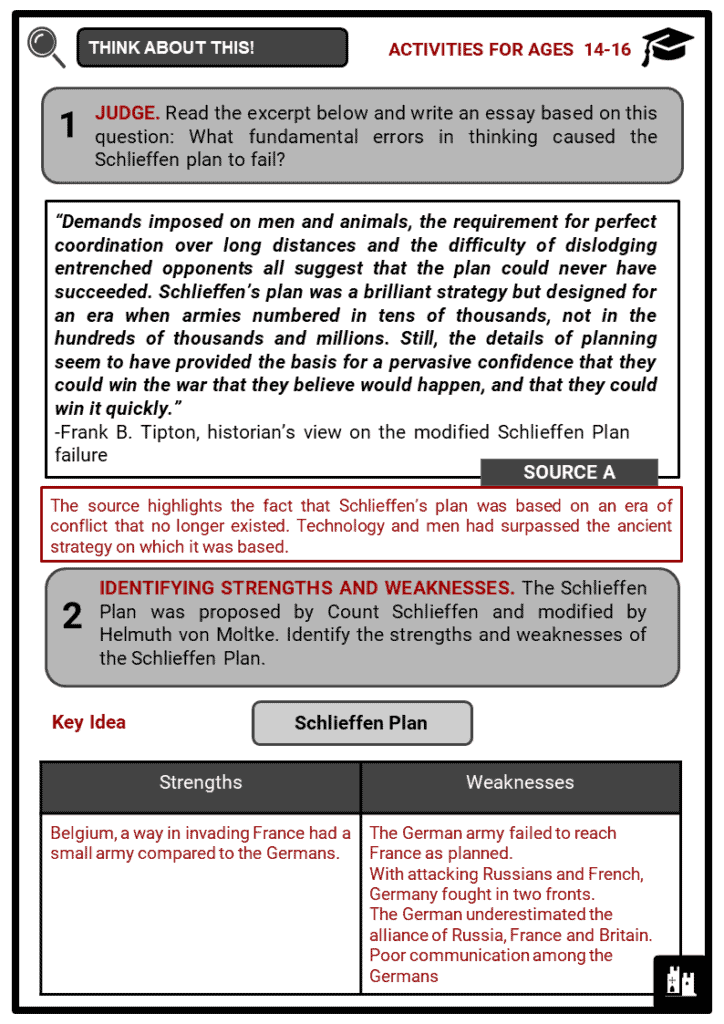Download The Schlieffen Plan Worksheets
Do you want to save dozens of hours in time? Get your evenings and weekends back? Be able to teach The Schlieffen Plan to your students?
Our worksheet bundle includes a fact file and printable worksheets and student activities. Perfect for both the classroom and homeschooling!
Table of Contents
Add a header to begin generating the table of contents
Summary
- The alliance of France, Britain, and Russia against Germany, and the formation of the Schlieffen Plan
- The fundamental model and composition of the Schlieffen Plan
- Modification of the Schlieffen Plan
- The failure of the Schlieffen Plan
Key Facts And Information
Let’s know more about the Schlieffen Plan
- In 1904, the Entente Cordiale was signed and France, Britain, and later Russia, entered into an alliance. The Schlieffen Plan was designed by Germany’s Field Marshal Alfred von Schlieffen in 1905-06 as a deployment plan against the alliance that surrounded it. At the centre of the Schlieffen Plan was that France would be defeated first, making it difficult for Russia and Britain to continue fighting. It was essential for Germany to strike quickly and defeat France before Russia could mobilise its army to aid France.
- The creator of the Schlieffen plan was Count Alfred von Schlieffen. He served as chief of the Imperial German General Staff from 1891 to 1906. His military career began at 15 years old, and he was recommended to General War School in 1858 at the age of 25. After years of military experience and rising in rank, Schlieffen devised the plan to protect Germany as it was surrounded by powerful countries.
The Formation of Schlieffen Plan
- France was the strongest of Germany’s enemies. Russia, an ally of France, but it was geographically separated by Germany and also did not have advanced military powers.
- For the plan to succeed, France would be defeated by concentrating the German army on the right wing, as Schlieffen assumed that France would defend itself on their common border near Metz. The German army could then move south to Paris.
- The invasion was planned to last for 45 days. And, because it would take Russia 6 weeks to mobilise, it would not be able to assist France.
- Germany would then be able to take on Russia after defeating France and moving its soldiers to the already blocked Germany-Russia borders.
- Schlieffen sought to imitate Hannibal by inciting a battle of enormous force, to bring a about a quick and decisive triumph. He chose to defeat France first. Russia would follow after the French had been destroyed.
The Fundamentals and Composition of the Schlieffen Plan
- Schlieffen planned to attack France via Holland, Luxembourg and Belgium (which was neutral) before Russia could intervene.
- The right wing of the German force would attack the back of the French army that was situated on the common border by passing through Belgium.
- The group in the middle would attack the French at La Feré and Paris, encompassing the capital on the north and east.
- The third gathering would focus on the southernmost region.
- The last gathering consisted of three mounted force divisions on the left wing. It was intended to hinder any French endeavour to counterattack, and it could be withdrawn and transported to the right, if necessary.
Modification of the Schlieffen Plan
- Helmuth von Moltke succeeded Schlieffen and took charge as the German Chief of Army Staff in 1906. He modified the plan by:
- removing Holland from the countries to be invaded, and Flanders would be the main route.
- reducing German forces making up the right hook attack into France and invading through Belgium, but not the Netherlands, during the initial offensive.
- Belgium’s small army would not be able to stop German forces from quickly entering France. Thus, 36 divisions were ordered to invade Belgium. Eight divisions were kept back to stop the Russian army’s advance.
Timeline of Events
- August 1914
- On 1 August 1914, Germany declared war on Russia, but Russia refused.
- On 2 August, the Schlieffen Plan was executed when Germany demanded Belgium let it pass through to France, but Belgium refused. Britain also demanded Germany respect Belgium’s neutrality, but Germany refused. On 4 August, Britain sent troops to support France and fight Germany. Consequently, Germany
- Was unable to secure French forts by 5 August.
- France was not wholly unprepared. To counter the German army threat, France launched Plan XVII, which was a general offensive across the France-Germany border in Alsace-Lorraine. It had previously been French territory until 1871 when the new German Empire seized it after the Franco-Prussian War. Recapturing Alsace-Lorraine was, thus, high on France’s agenda. On 14 August, the Battle of Lorraine began.
- The Schlieffen hinged on Russia taking time to mobilise. However, on 17 August, the Russian army quickly moved into East Prussia. This meant Germany was fighting on two fronts at the same time rather than just one at a time, as originally planned.
- On 18 August, the French army took Sarrebourg, a commune in the Moselle district in Grand Est in north-eastern France. The German army, under the control of General Krafft von Dellmensingen, maintained contact with the French, but withdrew from any serious confrontation.
- 19-20 August saw the start of the Battle of the Frontiers of France, where the German army set up a trap to hamper the French army. The French army was defeated and suffered heavy losses and the armies of both sides retreated to River Meurthe.
- Helmuth von Moltke was persuaded by Prince Ruperchet and General Heeringen to then launch a series of counter attacks on French lines from 25 August into the month of September. Von Moltke realised, however, that because of his adjustments to the plan, he did not have the necessary troops.
- The extension caused a series of battles such as the Battle of the Ardennes (20-25 August), which was a part of the larger Battle of the Frontiers of France. It was fought between French and German armies of roughly equal size – both sides committed eight Corps to the battle.
- On 21-23 August, the Battle of Sambre took place where the Germans went to Belgium, passing the France-German borders and continued on their way to Paris before going east to strike the French army along the border between Germany and Switzerland.
- September 1914
- On 3 September, the French forces’ Commander-in-Chief, Joseph Joffre, gave orders for his army to draw back to a line along the River Seine. The commander of the British Expenditure Army, Sir John French, agreed on joining the French forces to attack the German army.
- On 5 September, Britain saw the German army make a critical error: In order to ruin the enemy force, the German army formed a curve, which created a weak spot. The first line of the army was the strongest, but France and Britain hit the support army, which had the weaker line.
- On the morning of 6 September, the 1st German army was attacked by the French 6th army. The force was ordered by General Alexander von Kluck to meet the attack by opening a gap of fifty kilometres between the German 2nd army and the French armies, which were led by General Karl von Bulow. This caused the German armies to split when the French 5th army and the British troops advanced.
- On 7 September, the German army was in danger from a French flank attack and had to troop back across the Marne. An attack was launched against the French army, which further weakened the German army. The movement created a gap between the German and French armies. This allowed the French army that was moving south to turn on Germany’s right flank. On 9 September, the German army moved back, meaning the British and French forces could now cross the line of the Marne.
The failure of the modified Schlieffen Plan by Helmuth von Moltke
- The modification made by Helmuth von Moltke was the root cause of the failure of the whole plan, as things did not go as expected.
- The plan worked initially, but there were too many flaws in the modifications for it to be successful. The tables were turned during the Battle of the Marne, where it was very obvious that things were not in Germany’s favour anymore.
- Poor communication
- Another reason for failure was due to weak and unstable communication. Some soldiers backed out of the plan due to the high threats and dangers it posed, which meant the plan never achieved its full power.
- Germany underestimating its opponents
- The Russians sent troops to the border much sooner than expected. This made von Moltke send more troops eastward, which doomed the entire plan as the Schlieffen Plan required a significant force attacking France. Von Moltke also assumed that Belgium would not give much opposition, but it did and significantly held up the Germans.
- The plan was supposed to succeed in six weeks (the amount of time Germany assumed it would take Russia to mobilise) and was designed as a battle of annihilation. If the time frame seems short, it should be remembered that the Franco-Prussian War and the Battle of France in 1940 were both decided in the same amount of time.
- Belgian resistance was stronger than expected. The Belgian forts at Liége held out for 12 days, and Brussels was not occupied until 20 August.
- British Expeditionary Force (BEF) participation for Belgium
- One reason is that the British sent an Expeditionary Force (BEF) of 80,000 men to Belgium. They met the Germans at Mons on 23 August and again at Le Cateau on 26 August. Although the British were forced to retreat at Mons, they managed to inflict heavy casualties on the Germans before issuing a tactical retreat to Paris.
- Weapons used by British Army are more advanced than the Germans
- The British were professional soldiers equipped with the new Lee Enfield Mark III rifle. They were heavily outnumbered, but their rapid and accurate rifle fire slowed down the advance of the German conscripts. One German officer wrote in a letter: “It seemed as though there was a machine gun behind every bush.”
- On November 1914, the German army entrenched themselves in Northern France and Western Belgium.






